Abstract
1 Rats were pretreated with capsaicin (50 mg/kg, s.c.) on the 2nd, 10th, or 20th day of life. Three months later immunoreactive substance P (I—SP) was determined in skin, sensory nerves and the central nervous system. Neurogenic plasma extravasation was also examined.
2 Pretreatment at the age of 2 or 10 days resulted in a decrease (26 to 69%) of I—SP in skin, saphenous and vagus nerve, dorsal roots, dorsal half of the spinal cord, and medulla oblongata. The I—SP content of the ventral half of the spinal cord, of midbrain, hypothalamus, striatum, cortex, and cerebellum remained unchanged. Neurogenic plasma extravasation was inhibited by more than 80%.
3 In contrast to this irreversible effect of capsaicin on newborn rats, pretreatment of 20 day old rats led to reversible depletion of I—SP and to reversible impairment of neurogenic plasma extravasation.
4 Capsaicin pretreatment of adult rats caused a marked depletion of I—SP in the skin of the hind paw and an impairment of neurogenic plasma extravasation. A similar decrease of I—SP was seen after chronic denervation of the skin.
5 Intra-arterial infusion of substance P (threshold dose 5 × 10-13 mol/min) or physalaemin induced dose-dependent plasma extravasation. Somatostatin, vasoactive intestinal polypeptide, caerulein and the enkephalin-analogue FK 33-824 were ineffective in doses 100 fold higher.
6 The results indicate that the action of capsaicin on substance P neurones is restricted to primary sensory neurones. Since in every case a decreased substance P content of the skin was associated with impaired neurogenic plasma extravasation, it is suggested that release of substance P is involved in neurogenic plasma extravasation.
Full text
PDF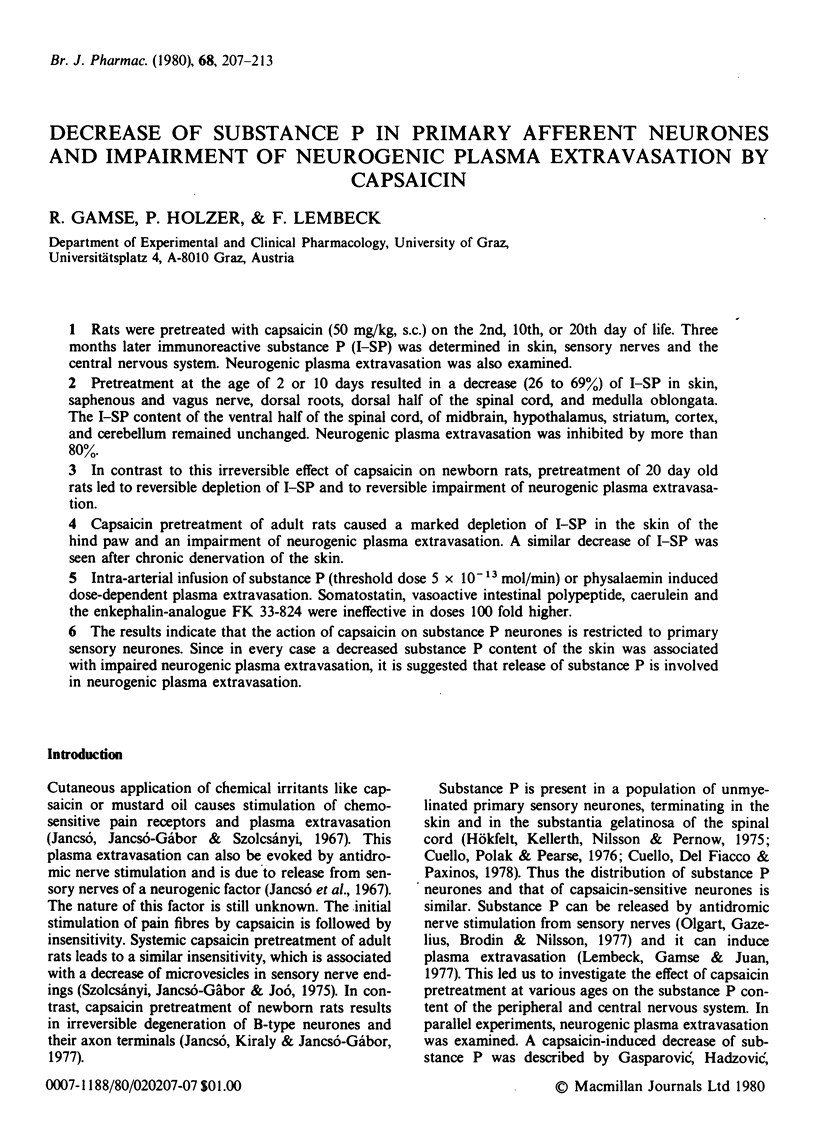
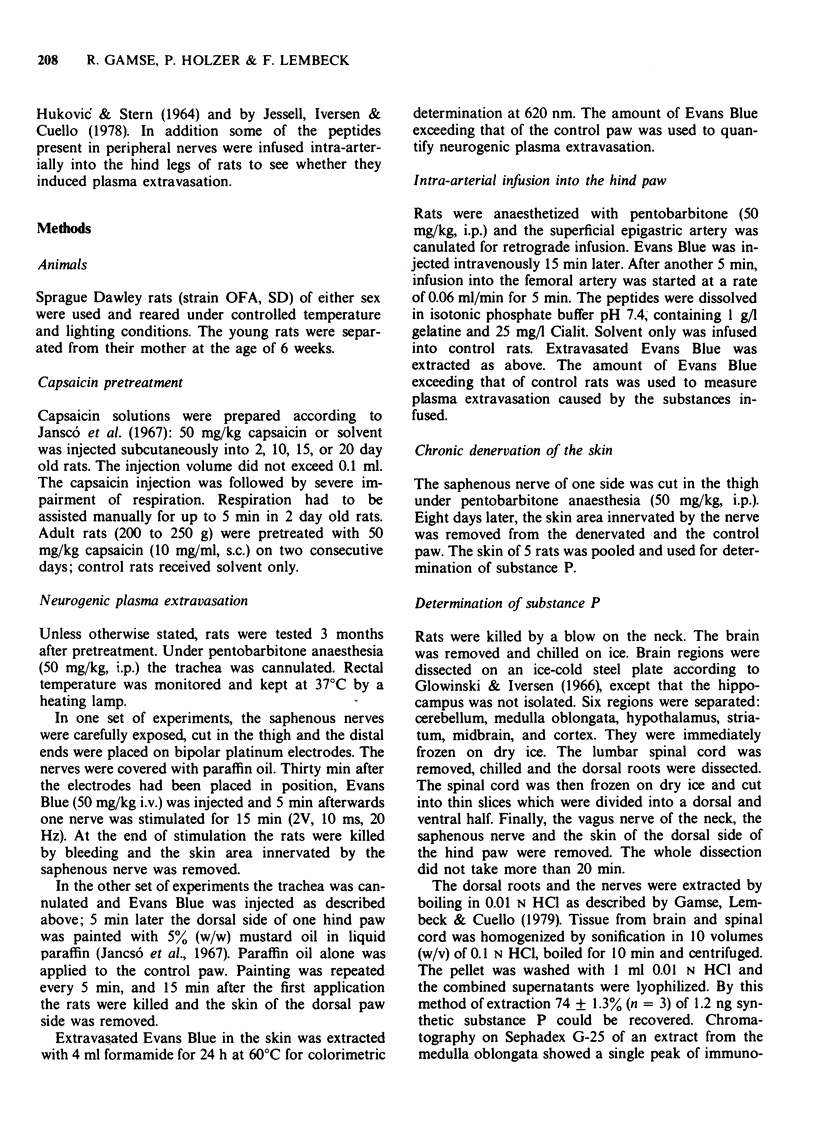
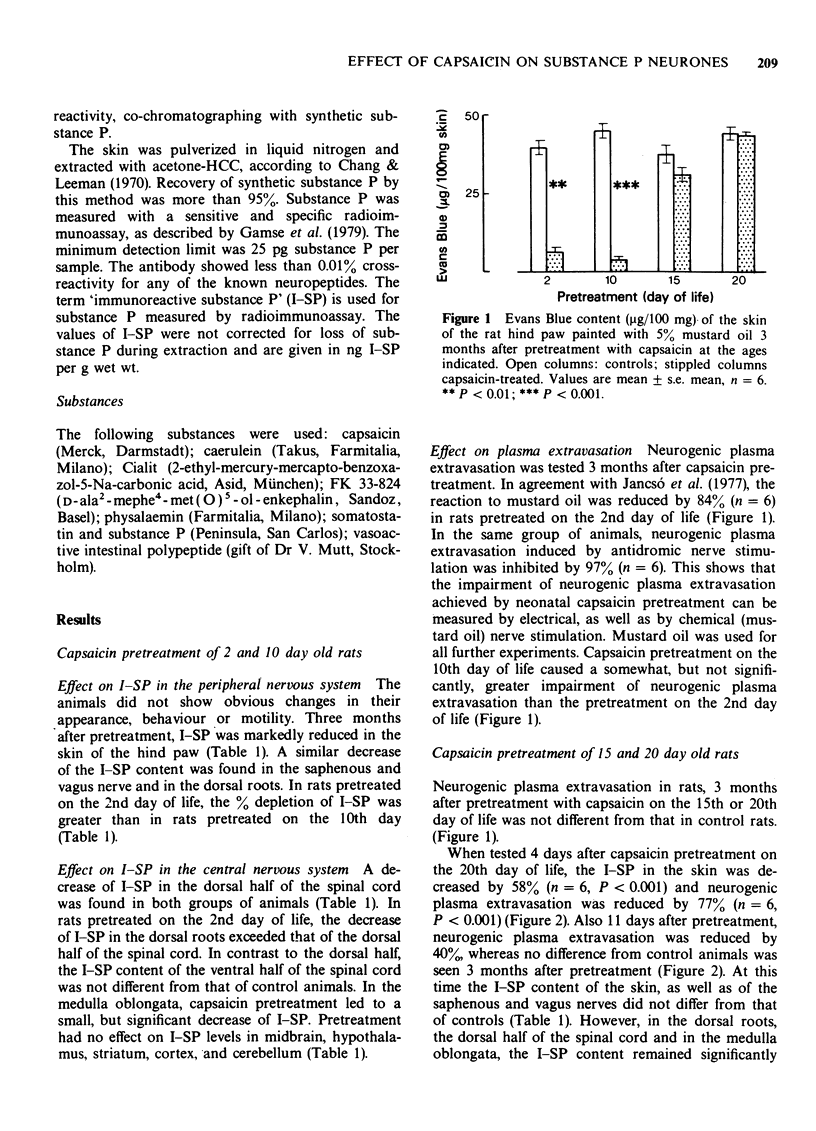

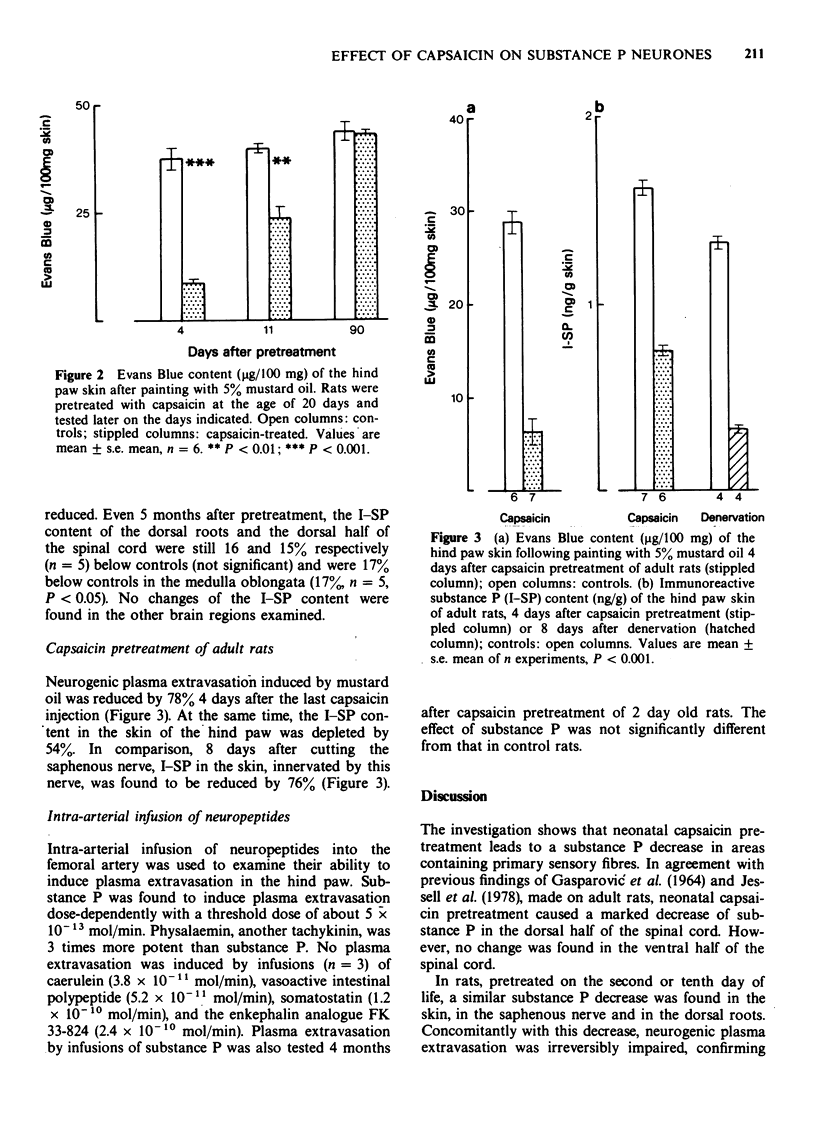
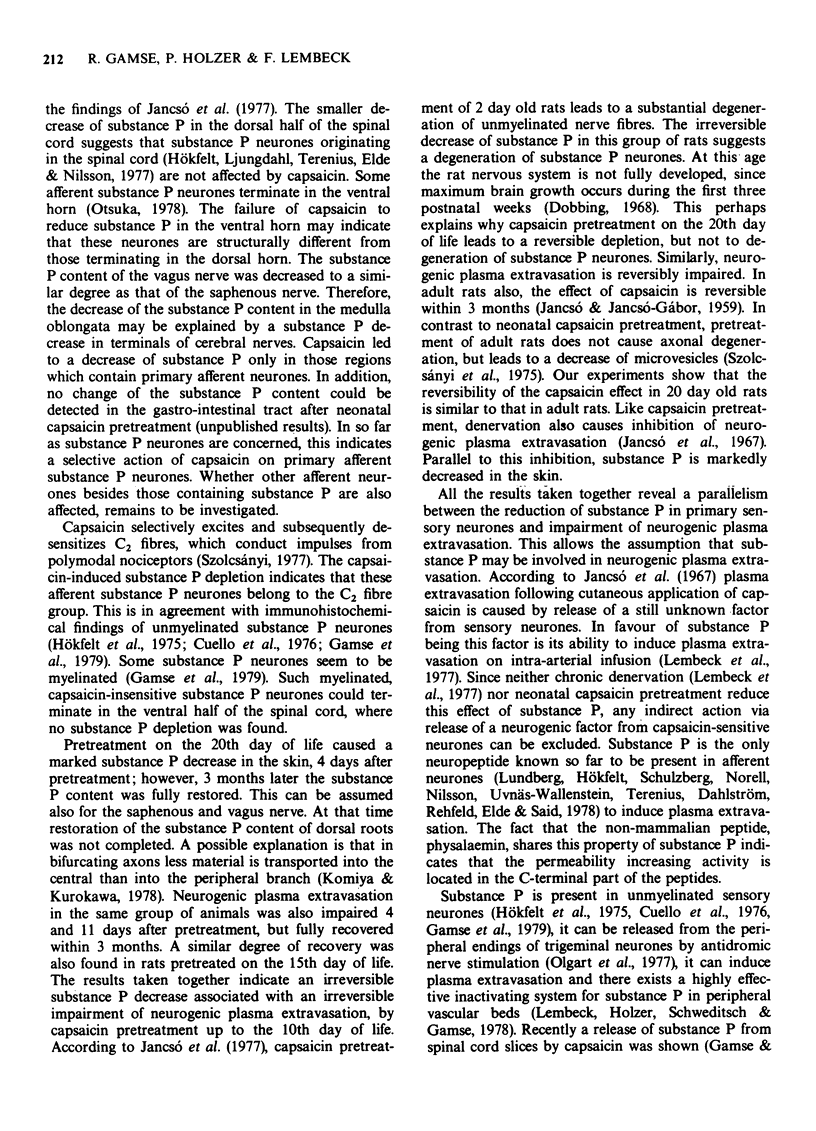
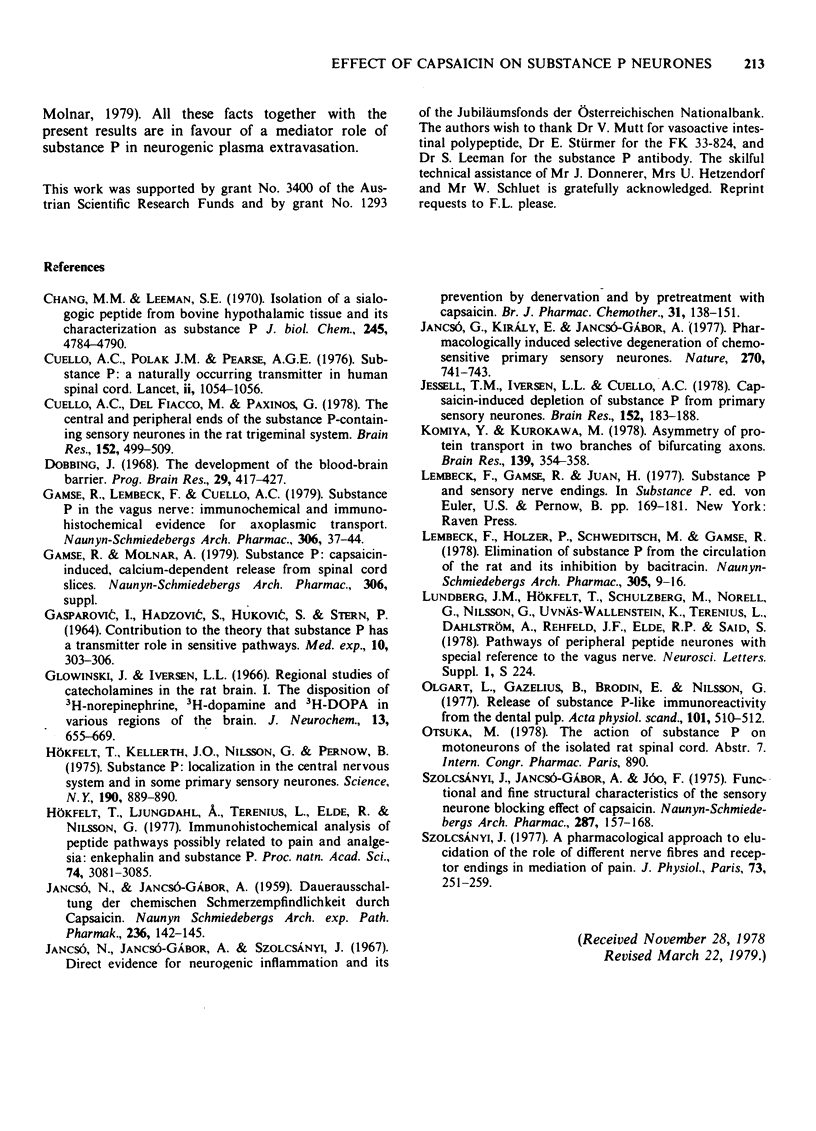
Selected References
These references are in PubMed. This may not be the complete list of references from this article.
- Chang M. M., Leeman S. E. Isolation of a sialogogic peptide from bovine hypothalamic tissue and its characterization as substance P. J Biol Chem. 1970 Sep 25;245(18):4784–4790. [PubMed] [Google Scholar]
- Cuello A. C., Del Fiacco M., Paxinos G. The central and peripheral ends of the substance P-containing sensory neurones in the rat trigeminal system. Brain Res. 1978 Sep 8;152(3):499–500. doi: 10.1016/0006-8993(78)91105-8. [DOI] [PubMed] [Google Scholar]
- Cuello A. C., Polak J. M., Pearse A. G. Substance P: a naturally occurring transmitter in human spinal cord. Lancet. 1976 Nov 13;2(7994):1054–1056. doi: 10.1016/s0140-6736(76)90968-5. [DOI] [PubMed] [Google Scholar]
- Dobbing J. The development of the blood-brain barrier. Prog Brain Res. 1968;29:417–427. doi: 10.1016/S0079-6123(08)64172-2. [DOI] [PubMed] [Google Scholar]
- GASPAROVIC I., HADZOVIC S., HUKOVIC S., STERN P. CONTRIBUTION TO THE THEORY THAT SUBSTANCE P HAS A TRANSMITTER ROLE IN SENSITIVE PATHWAY. Med Exp Int J Exp Med. 1964;10:303–306. [PubMed] [Google Scholar]
- Gamse R., Lembeck F., Cuello A. C. Substance P in the vagus nerve. Immunochemical and immunohistochemical evidence for axoplasmic transport. Naunyn Schmiedebergs Arch Pharmacol. 1979 Jan;306(1):37–44. doi: 10.1007/BF00515591. [DOI] [PubMed] [Google Scholar]
- Glowinski J., Iversen L. L. Regional studies of catecholamines in the rat brain. I. The disposition of [3H]norepinephrine, [3H]dopamine and [3H]dopa in various regions of the brain. J Neurochem. 1966 Aug;13(8):655–669. doi: 10.1111/j.1471-4159.1966.tb09873.x. [DOI] [PubMed] [Google Scholar]
- Hökfelt T., Kellerth J. O., Nilsson G., Pernow B. Substance p: localization in the central nervous system and in some primary sensory neurons. Science. 1975 Nov 28;190(4217):889–890. doi: 10.1126/science.242075. [DOI] [PubMed] [Google Scholar]
- Hökfelt T., Ljungdahl A., Terenius L., Elde R., Nilsson G. Immunohistochemical analysis of peptide pathways possibly related to pain and analgesia: enkephalin and substance P. Proc Natl Acad Sci U S A. 1977 Jul;74(7):3081–3085. doi: 10.1073/pnas.74.7.3081. [DOI] [PMC free article] [PubMed] [Google Scholar]
- Jancsó G., Kiraly E., Jancsó-Gábor A. Pharmacologically induced selective degeneration of chemosensitive primary sensory neurones. Nature. 1977 Dec 22;270(5639):741–743. doi: 10.1038/270741a0. [DOI] [PubMed] [Google Scholar]
- Jancsó N., Jancsó-Gábor A., Szolcsányi J. Direct evidence for neurogenic inflammation and its prevention by denervation and by pretreatment with capsaicin. Br J Pharmacol Chemother. 1967 Sep;31(1):138–151. doi: 10.1111/j.1476-5381.1967.tb01984.x. [DOI] [PMC free article] [PubMed] [Google Scholar]
- Jessell T. M., Iversen L. L., Cuello A. C. Capsaicin-induced depletion of substance P from primary sensory neurones. Brain Res. 1978 Aug 18;152(1):183–188. doi: 10.1016/0006-8993(78)90146-4. [DOI] [PubMed] [Google Scholar]
- Komiya Y., Kurokawa M. Asymmetry of protein transport in two branches of bifurcating axons. Brain Res. 1978 Jan 13;139(2):354–358. doi: 10.1016/0006-8993(78)90936-8. [DOI] [PubMed] [Google Scholar]
- Lembeck F., Holzer P., Schweditsch M., Gamse R. Elimination of substance P from the circulation of the rat and its inhibition by bacitracin. Naunyn Schmiedebergs Arch Pharmacol. 1978 Oct;305(1):9–16. doi: 10.1007/BF00497000. [DOI] [PubMed] [Google Scholar]
- Olgart L., Gazelius B., Brodin E., Nilsson G. Release of substance P-like immunoreactivity from the dental pulp. Acta Physiol Scand. 1977 Dec;101(4):510–512. doi: 10.1111/j.1748-1716.1977.tb06040.x. [DOI] [PubMed] [Google Scholar]
- Szolcsányi J. A pharmacological approach to elucidation of the role of different nerve fibres and receptor endings in mediation of pain. J Physiol (Paris) 1977 Sep;73(3):251–259. [PubMed] [Google Scholar]
- Szolcsányi J., Jancśo-Gábor A., JOO F. Functional and fine structural characteristics of the sensory neuron blocking effect of capsaicin. Naunyn Schmiedebergs Arch Pharmacol. 1975;287(2):157–169. doi: 10.1007/BF00510447. [DOI] [PubMed] [Google Scholar]


